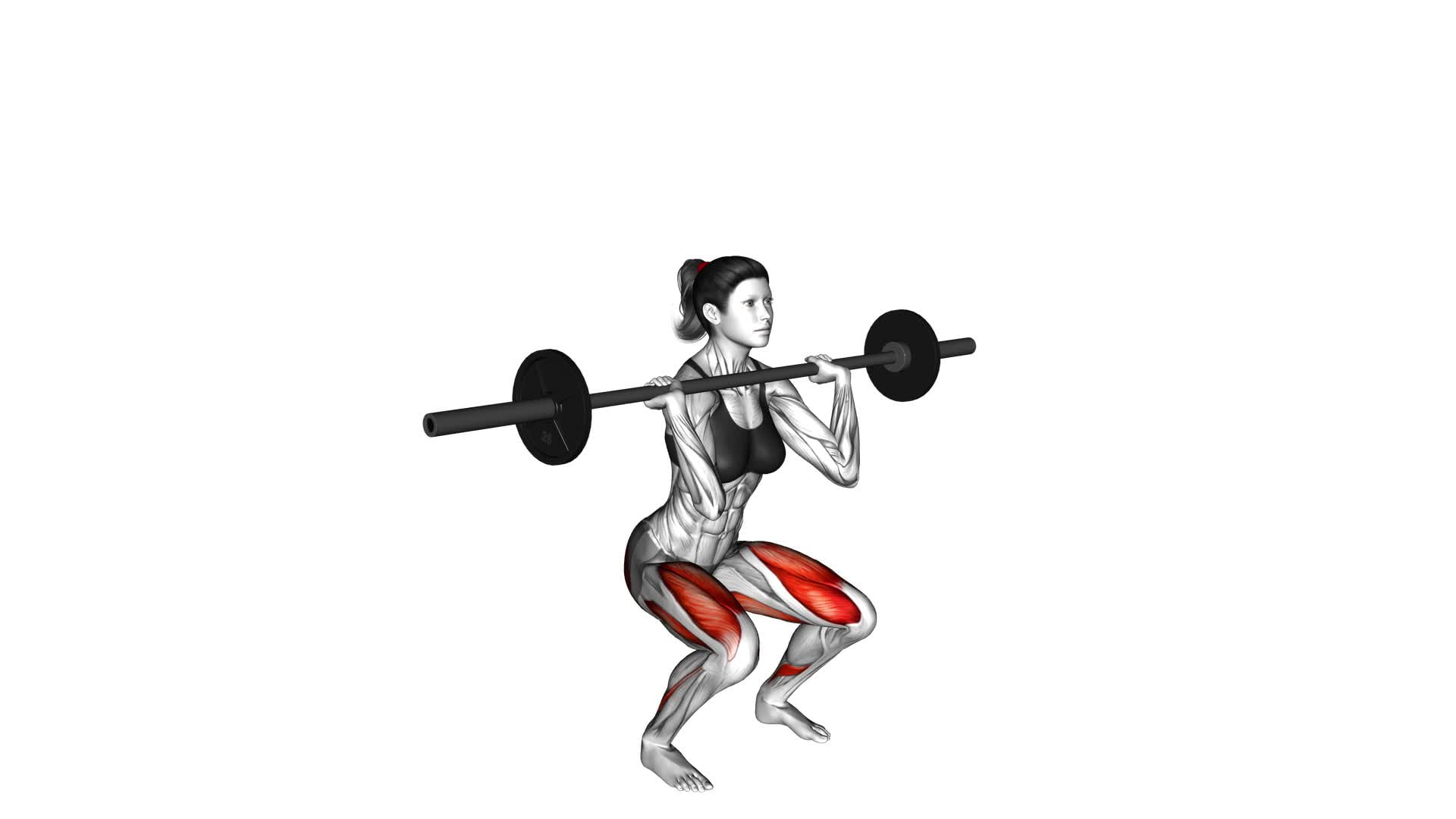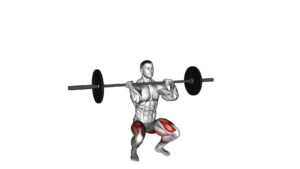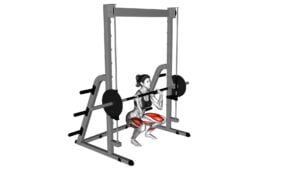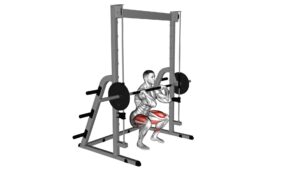Barbell Clean Grip Front Squat (Female) – Video Exercise Guide & Tips

Are you looking to strengthen your lower body and improve your squat technique?
Watch This Exercise Video
The Barbell Clean Grip Front Squat is a fantastic exercise for achieving just that.
In this video exercise guide, we'll walk you through the proper set-up and grip technique, as well as key points to maintain a strong and stable front squat.
Whether you're a beginner or an experienced fitness enthusiast, this guide is packed with tips and modifications to help you progress.
Let's get started!
Key Takeaways
- Barbell Clean Grip Front Squat targets quads, glutes, and hamstrings.
- Proper set-up and grip technique are crucial for stability and efficiency.
- Engaging the core and maintaining proper bar placement are essential for a strong and stable front squat.
- Common mistakes to avoid include improper wrist position, lack of depth, rounded back form, and poor grip on the barbell.
Benefits of the Barbell Clean Grip Front Squat
The Barbell Clean Grip Front Squat offers numerous benefits for women looking to strengthen their lower body and improve overall fitness. This variation of the front squat is highly effective in targeting the quads, glutes, and hamstrings, providing a challenging workout for these muscle groups. Unlike other squat variations, the barbell clean grip front squat places more emphasis on the quadriceps, allowing for greater activation and development of this muscle group.
One of the key benefits of the barbell clean grip front squat is its ability to improve core strength and stability. By holding the barbell in front of your body, you're forced to engage your core muscles to maintain proper form and balance throughout the exercise. This not only strengthens your core, but also improves your overall functional fitness, making daily activities easier and reducing the risk of injury.
Furthermore, the barbell clean grip front squat offers a great opportunity to improve your mobility and flexibility. As you lower into the squat, you're required to maintain an upright posture, which helps to improve hip and ankle mobility. This can be particularly beneficial for women who may have tight hip flexors or limited ankle range of motion.
Proper Set-Up and Grip Technique
To properly set up and execute the barbell clean grip front squat, you need to ensure that your grip technique is correct. The proper form and grip will allow for maximum stability and efficiency during the exercise.
Start by gripping the barbell with an overhand grip, slightly wider than shoulder-width apart. Your thumbs should be wrapped around the bar, securing it in place. Make sure to keep your wrists in a neutral position to avoid strain.
As you lift the barbell onto your shoulders, make sure it's resting on the front deltoids, just below the collarbone. This will help with weight distribution and balance.
Throughout the exercise, maintain a tight grip on the barbell to prevent it from slipping or moving.
Key Points for a Strong and Stable Front Squat
To perform a strong and stable front squat, there are several key points to keep in mind.
First, engaging your core is crucial for maintaining proper form and stability throughout the exercise.
Secondly, ensuring the bar is placed correctly on your shoulders will help distribute the weight evenly and prevent unnecessary strain.
Lastly, paying attention to your breathing technique, such as taking deep breaths and exhaling on the exertion, will provide additional support and help you generate more power during the movement.
Remember to focus on these key points to optimize your front squat performance.
Core Engagement Importance
Maintain a strong core for a stable and powerful front squat.
Core engagement is crucial for maintaining proper form and maximizing the benefits of this exercise.
Here are some key points to consider for core stability and muscle activation during the front squat:
- Brace your core: Before descending into the squat, engage your core muscles by drawing your belly button towards your spine. This will create a stable foundation for the movement.
- Maintain an upright torso: A strong core helps you keep your torso upright throughout the squat. This not only prevents excessive forward lean but also activates the muscles in your midsection.
- Control your breathing: Focusing on your breath can help you maintain core stability. Take a deep breath at the top, hold it as you descend, and exhale forcefully as you come back up.
Proper Bar Placement
To ensure a strong and stable front squat, it's important to focus on proper bar placement. The right placement of the bar on your shoulders will allow for optimal weight distribution and prevent unnecessary strain on your wrists.
There are various bar placement variations that you can try to find what works best for you. One common technique is the clean grip, where the bar rests on your fingertips with your elbows pointing forward. Another option is the cross-arm grip, where one hand is placed over the bar and the other hand is placed under the bar, crossing your arms.
Experiment with these alternative grip techniques to find the most comfortable and secure position for your front squat.
Now that you understand the importance of bar placement, let's move on to the significance of proper breathing technique.
Breathing Technique Significance
Now that you understand the importance of proper bar placement, it's crucial that you focus on your breathing technique to achieve a strong and stable front squat. Proper breathing technique provides several benefits that can greatly enhance your performance and safety during this exercise. Here are some key points to keep in mind:
- Increased Stability: Proper breathing cues, such as taking a deep breath and bracing your core before descending into the squat, help create intra-abdominal pressure. This pressure enhances stability and supports your spine, allowing you to maintain proper form throughout the movement.
- Improved Strength and Power: By utilizing the correct breathing technique, you can optimize the engagement of your core muscles and increase your overall strength and power output. This can lead to better performance and results in your front squats.
- Enhanced Safety: Paying attention to your breathing during the front squat not only improves stability but also helps prevent injury. Proper breathing cues ensure that your core and other supporting muscles are actively engaged, reducing the risk of strain or imbalance.
Common Mistakes to Avoid
To ensure proper form and maximize the effectiveness of your barbell clean grip front squat, there are a few common mistakes that you should avoid.
First, be mindful of your wrist position; improper positioning can lead to discomfort and potential injury.
Additionally, make sure to achieve proper depth in your squat, as failing to go low enough can limit the engagement of key muscle groups.
Lastly, maintain a straight back throughout the movement to avoid rounding and potential strain on your spine.
Improper Wrist Position
Avoid the improper wrist position when performing the barbell clean grip front squat. Proper wrist position is crucial for maintaining stability and preventing injury during this exercise. Here are common mistakes to avoid and modifications and progressions to help you improve your wrist position:
- Mistake 1: Wrists bent backward: This puts excessive strain on the wrists and can lead to discomfort or injury. Keep your wrists in a neutral position throughout the movement.
- Mistake 2: Wrists flexed forward: This can limit your ability to properly grip the barbell and decrease your overall strength. Make sure to maintain a firm grip on the bar with your wrists in line with your forearms.
- Mistake 3: Uneven wrist position: Having one wrist higher than the other can cause imbalances and affect your stability. Focus on keeping both wrists at the same level to ensure proper alignment.
Lack of Depth
Maintain proper depth during the barbell clean grip front squat to maximize the effectiveness of the exercise and prevent potential mistakes. Lack of depth is a common mistake that can limit the benefits of this exercise.
To improve depth, focus on flexibility exercises that target the hips, ankles, and lower back. These exercises can help increase your range of motion, allowing you to squat deeper. Incorporate exercises such as hip flexor stretches, ankle mobility drills, and lower back stretches into your warm-up routine.
Additionally, practicing proper squat technique is crucial. Ensure that your knees track over your toes, your chest stays upright, and your hips lower parallel to the ground.
Rounded Back Form
Ensure that you maintain a straight back throughout the barbell clean grip front squat to avoid rounding your back, which is a common mistake. When your back is rounded, it puts unnecessary stress on your spine and can lead to injury. To prevent this, keep the following in mind:
- Engage your core muscles: By activating your core, you can support your spine and maintain a neutral back position.
- Focus on your upper back: Squeezing your shoulder blades together helps to keep your upper back straight and prevents rounding.
- Keep your chest up: Imagining a string pulling your chest towards the ceiling can help you maintain a straight back.
Modifications and Progressions for All Fitness Levels
To adapt the barbell clean grip front squat for all fitness levels, start by adjusting the weight load and gradually increasing intensity.
This exercise can be modified to accommodate beginners by using lighter weights or even just body weight. For beginners, it's important to focus on proper form and technique before adding additional weight.
One modification for beginners is to perform the front squat with a kettlebell or dumbbell held at chest level instead of using a barbell. This can help build strength and stability in the lower body without the added challenge of balancing a barbell.
Another modification is to perform the front squat with a resistance band around the thighs. This can help activate the muscles of the hips and glutes, making the exercise more accessible for beginners.
As you progress and become more comfortable with the movement, you can gradually increase the weight load by adding more plates to the barbell. It's important to listen to your body and only increase the weight when you feel ready.
Video Tutorial: Step-by-Step Guide for the Barbell Clean Grip Front Squat
To properly perform the barbell clean grip front squat, you should begin by positioning the barbell across your front shoulders, resting on your collarbone, with your hands gripping the bar just outside of shoulder width. This grip allows for a secure hold and helps to maintain proper form throughout the exercise. Here is a step-by-step guide to help you master the barbell clean grip front squat:
- Start by standing with your feet shoulder-width apart, toes slightly turned out.
- Engage your core and keep your chest up as you lower into a squat position, pushing your hips back and bending your knees.
- As you descend, keep your weight in your heels and your knees tracking over your toes.
- Continue lowering until your thighs are parallel to the ground, or as low as your flexibility allows.
- Drive through your heels to push back up to the starting position, keeping your chest lifted and core engaged.
- Repeat for the desired number of repetitions.
Benefits of front squats for women include:
- Increased core strength and stability
- Improved lower body strength and muscle tone
- Enhances balance and coordination
If the barbell clean grip front squat is too challenging or uncomfortable for you, there are alternative exercises you can try:
- Goblet squats: Hold a dumbbell or kettlebell at your chest and perform squats in the same manner.
- Dumbbell front squats: Hold dumbbells at your sides, with your palms facing inwards, and perform squats.
- Bodyweight squats: Perform squats without any additional weight, focusing on maintaining proper form and increasing depth over time.
Remember to consult with a fitness professional before attempting any new exercise and always listen to your body to avoid injury.
Frequently Asked Questions
Can the Barbell Clean Grip Front Squat Help Improve Upper Body Strength?
The barbell clean grip front squat is a great exercise for improving upper body strength. By incorporating the clean grip, you engage the muscles in your upper back, shoulders, and arms, making it a full-body exercise.
This variation of the front squat also helps improve core stability and overall balance.
What Are Some Alternative Exercises for the Barbell Clean Grip Front Squat?
Looking for alternative exercises to the barbell clean grip front squat?
There are a few options you can try. One modification is the dumbbell front squat, where you hold dumbbells at your shoulders instead of a barbell.
Another alternative is the goblet squat, which involves holding a weight in front of your chest.
Both of these exercises target similar muscle groups and can be effective substitutes for the barbell clean grip front squat.
How Often Should the Barbell Clean Grip Front Squat Be Incorporated Into a Workout Routine?
To maximize your workout routine, it's important to consider the frequency of incorporating the barbell clean grip front squat.
By adding this exercise regularly, you can reap its numerous benefits. This compound movement engages multiple muscle groups, helping to build strength and improve overall stability. It also enhances core strength and promotes better posture.
Aim to include the barbell clean grip front squat in your routine at least 2-3 times per week for optimal results.
Can the Barbell Clean Grip Front Squat Help Improve Flexibility and Mobility?
The barbell clean grip front squat can significantly improve your flexibility and mobility. By engaging multiple muscle groups and forcing you to maintain an upright posture, this exercise helps to increase the range of motion in your hips, ankles, and shoulders.
The clean grip also requires wrist flexibility, which can be developed through consistent practice. Incorporating this squat into your workout routine won't only strengthen your lower body, but also enhance your overall flexibility and mobility.
What Are Some Common Ways to Prevent Wrist Discomfort During the Barbell Clean Grip Front Squat?
To prevent wrist discomfort during the barbell clean grip front squat, there are a few common techniques you can try.
- First, make sure you have a proper grip on the barbell, with your fingers securely wrapped around it.
- Secondly, focus on keeping your elbows high and your wrists straight throughout the movement. This will help distribute the weight evenly and reduce strain on your wrists.
- Lastly, consider using wrist wraps or tape for added support.
Incorporating these techniques can help you perform the exercise safely and comfortably.
Additionally, the barbell clean grip front squat is beneficial for upper body strength, as it engages the muscles in your shoulders, upper back, and arms.
Conclusion
In conclusion, the barbell clean grip front squat is a highly effective exercise for strengthening the lower body and core muscles. By following the proper set-up and grip technique, along with maintaining key points for stability, you can achieve a strong and stable front squat.
It's important to avoid common mistakes and make modifications or progressions based on your fitness level. Watch the video tutorial for a step-by-step guide on performing the barbell clean grip front squat correctly.

Author
Years ago, the spark of my life’s passion ignited in my mind the moment I stepped into the local gym for the first time. The inaugural bead of perspiration, the initial endeavor, the very first surge of endorphins, and a sense of pride that washed over me post-workout marked the beginning of my deep-seated interest in strength sports, fitness, and sports nutrition. This very curiosity blossomed rapidly into a profound fascination, propelling me to earn a Master’s degree in Physical Education from the Academy of Physical Education in Krakow, followed by a Sports Manager diploma from the Jagiellonian University. My journey of growth led me to gain more specialized qualifications, such as being a certified personal trainer with a focus on sports dietetics, a lifeguard, and an instructor for wellness and corrective gymnastics. Theoretical knowledge paired seamlessly with practical experience, reinforcing my belief that the transformation of individuals under my guidance was also a reflection of my personal growth. This belief holds true even today. Each day, I strive to push the boundaries and explore new realms. These realms gently elevate me to greater heights. The unique combination of passion for my field and the continuous quest for growth fuels my drive to break new ground.







